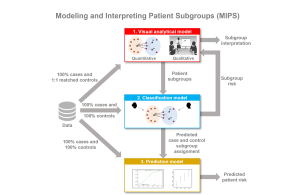
Source: Adobe Stock
Copyright: jovannig
URL: https://stock.adobe.com/ca/images/caregiving-nurse-happy-with-elder-patient-in-hospital-bed/125717222
License: Licensed by JMIR
The University of Texas Medical Branch at Galveston
UTMB Media Hotline: 409-772-NEWS (6397)
Please Note: Our studio is equipped with a technology that enables us to transmit live or taped HD or SD video over the Internet. For video interviews, contact us at 409-772-6397.
Contact Dizhi Marlow at 409-747-0794 or dgmarlow@utmb.edu
For Immediate Release: December 7, 2022
Key Point
- UTMB researchers developed machine learning methods that can automatically find conditions that frequently go together in national level data, and used them to predict the risk of a patient in the clinic, and for designing targeted treatments.
- “Such information, derived from national level data, can be powerful to complement a doctor in designing treatments that are more targeted to patients profiles, resulting in better outcomes with fewer side-effects.”
- Read the inspiration for the study and how it led to a letter from a US President.
GALVESTON, Texas – Imagine a 68-year-old patient who has COVID-19. Most likely she will also have high blood pressure and kidney problems as these issues often go together in older adults. When she goes to see a doctor, the treatment cannot just focus on the COVID-19 infection, but also needs to consider the other health conditions, and factor them into an overall health risk and treatment plan.
To help health care professionals find the connections between health conditions, risk and treatment plans, researchers at the University of Texas Medical Branch developed machine learning methods that can automatically find conditions that frequently go together in national level data, and used them to predict the risk of a patient in the clinic, and for designing targeted treatments.
“One of the challenges in treating patients with multiple conditions is to know which ones frequently go together, and their risk for negative outcomes like complications and having to return to the hospital” said Dr. Suresh K. Bhavnani, lead author of the study published in the Journal of Medical Informatics describing the machine learning method and professor of Biomedical Informatics at the School of Public and Population Health at UTMB. “Such information, derived from national level data, can be powerful to complement a doctor in designing treatments that are more targeted to patients profiles, resulting in better outcomes with fewer side-effects.”
In the study, funded by the Patient Centered Outcomes Research Institute (PCORI), researchers developed and tested a machine learning approach called Modeling and Interpreting Patient Subgroups (MIPS) to tackle the problem of hospital readmission in three conditions using national level data of more than 190,000 patients. This approach automatically identified and visualized disease subtypes in a way that clinicians could understand and design treatments. Subsequently, models automatically classified a new patient into one or more disease subtypes, and predicted that patient’s risk for being readmitted to the hospital.

“These patterns of ‘prior conditions that go together’ are known as disease subtypes,” Bhavnani said. “While numerous studies have identified disease subtypes, currently there is a gap in using them in the clinic to treat a specific patient.”
The results demonstrated a general way to integrate the identification of subtypes, visualize them so they could be understood by doctors for designing treatments, and use them to categorize patients and measure their risk. The researchers are currently testing the same approach to identify and predict the risk of subtypes in stroke patients undergoing rehabilitation, with an interface for a clinical decision support system which provides subtype and risk information for rapid use in the clinic.
“The integration of the visualization, classification, and prediction models in a general framework will be useful for treating a wide range of disease-specific subtypes,” said Dr. Mukaila Raji, co-author of the study and Director at the Division of Geriatric & Palliative Medicine at UTMB. “Such generalizable approaches can greatly accelerate the use of machine learning methods in the clinic to improve patient care.”
The University of Texas Medical Branch
Office of Marketing and Communications
301 University Boulevard, Suite 3.518
Galveston, Texas 77555-0144
@utmbnews
ABOUT THE UNIVERSITY OF TEXAS MEDICAL BRANCH: Texas’ first academic health center opened its doors in 1891 and today has four campuses, four health sciences schools, four institutes for advanced study, a research enterprise that includes one of only two national laboratories dedicated to the safe study of infectious threats to human health, a Level 1 Trauma Center and a health system offering a full range of primary and specialized medical services throughout the Texas Gulf Coast region. UTMB is an institution in the University of Texas System and a member of the Texas Medical Center.

Suresh K Bhavnani
Original article
Bhavnani SK, Zhang W, Visweswaran S, Raji M, Kuo YF A Framework for Modeling and Interpreting Patient Subgroups Applied to Hospital Readmission: Visual Analytical Approach JMIR Med Inform 2022;10(11):e37239
URL: https://medinform.jmir.org/2022/11/e37239
doi: 10.2196/37239
